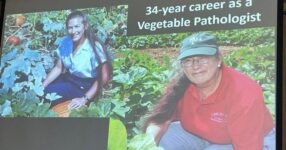COLLEGEVILLE, Pa. — Cornell University Professor Emeritus Margaret (Meg) McGrath spent 34 years studying vegetable pathology.
She credits much of what she learned to her home garden.
McGrath, who earned her Ph.D. from Penn State in 1988, gave an opening talk at the Commercial Vegetable Growers Winter Meeting Feb. 21 at Montgomery County 4-H Center.
“Doctor McGrath’s program was a combined applied research/Extension program that aimed to improve the management of important diseases of vegetable crops grown on Long Island with both conventional and organic production systems,” Penn State Extension horticulture educator Megan Chawner said in introducing McGrath. “She conducted decades of research to increase our understanding of these diseases and to develop effective components for integrated pest management programs.”
Cultural management practices are the foundation of any crop disease management program, McGrath said, but in many cases they are not enough.
“I think for me where that really hit home is also what I’ve learned through my home garden,” McGrath said, referencing persistent tomato diseases such as Septoria leaf spot and anthracnose.

Dr. Margaret McGrath.
“I leave no tomato debris behind in my own garden, which in home gardening you can do, and I still see a little bit of those diseases every year,” McGrath said. “So, foundation, but they won’t necessarily solve all your problems. And realize that they vary among diseases, and they’re based on knowledge of the pathogen’s biology.”
Knowing how a pathogen survives and thrives is critical to control, she said. Can it overwinter in soil? Can it travel long distances via spores dispersed by the wind? Can it be in seeds?
“You need to know all those things to know what cultural practices are appropriate for the particular diseases that you’re focused on,” McGrath said.
“Some of these cultural practices, in particular crop rotation, it is most important to be doing them before the pathogen population builds up. Once you’ve got a big problem, it’s going to take a number of years of rotation to really solve the issue you’ve gotten. So, you want a rotation to be top on your list if you’ve got crops for which there are diseases that the pathogen can survive in the soil.”
Besides rotating crop plantings, particularly targeting pathogens that survive in the soil, other recommended cultural disease management practices included:
• Growing resistant varieties
• Utilizing pathogen-free seed
• Separating crops susceptible to the same water- or wind-dispersed pathogens
• Utilizing plastic or organic mulch
• Diligent greenhouse sanitation practices targeting surviving pathogens, including cleaning and disinfecting benches and planting materials and avoiding reusing trays following bacterial disease
• Equally diligent field sanitation practices, such as cleaning and disinfecting equipment and boots between fields, cleaning and disinfecting tomato stakes (and discarding them if tomato canker was present), avoiding working in crops when leaves are wet (particularly when bacterial disease is present), and avoiding plant wounds.

A slide illustrates that vegetable pathogens change over time.
McGrath encouraged participants, who included commercial growers and also attendees needing continued education credits for pesticide licensure, to contact their land grant universities to let them know that field research has direct application for farmers and should be supported.
Following a day of workshops that included talks on tomato variety trials, collecting farmers market data, the Food Safety Modernization Act, sprayers and their calibration for vegetable farms, emerging berry crop insects and diseases, and resources for Spanish-speaking growers and employees, Penn State Extension horticulture educator Emelie Swackhamer, who was an undergrad when McGrath was a grad student at Penn State, recapped some highlights of McGrath’s talk and shone the spotlight on one particular legacy of her work.

“Over the years, one thing that she’s done that I use that I think is unique, I don’t know anywhere else to access this information in this format, are those tables she has of disease-resistance for vegetable varieties,” Swackhamer said.
“She has gone through the literature and the seed packets from companies, and then she has the tables. I use those.”
Swackhamer recalled taking the table for disease-resistant tomato varieties to a meeting once and having to print out and tape together several sheets of paper because the list was so vast.
“It’s just an incredible collection of information about disease resistance in vegetable varieties,” she said. “It’s important for all growers. Obviously, the organic growers really rely on disease resistance as a very important management tool. But for conventional growers, having disease-resistant plant material means they can spend less on their pesticide inputs and their time.”
Find McGrath’s tables for resistant varieties of 17 common vegetables here.




